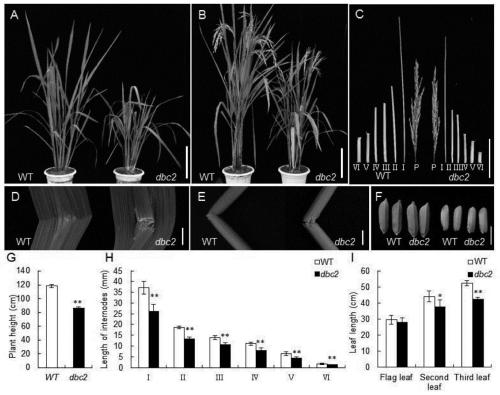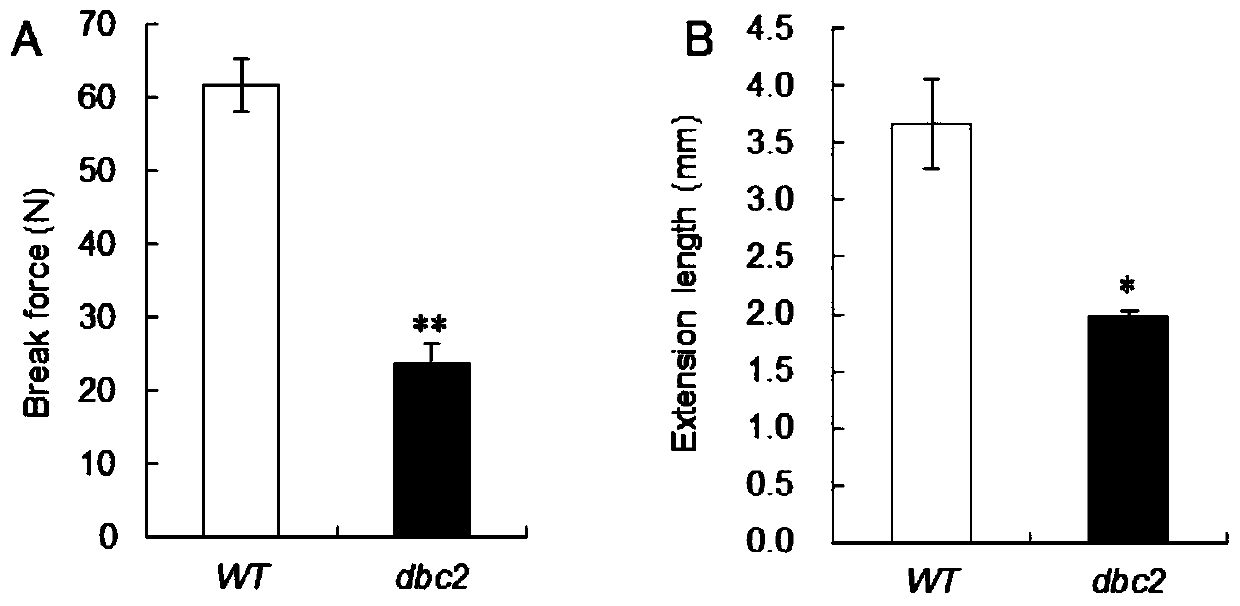Rice brittle stem regulatory gene DBC2 and application thereof
A technology for regulating genes and rice, which is applied in the fields of application, genetic engineering, plant gene improvement, etc., and can solve the problems that rice brittle stem characteristics cannot be applied and other problems
- Summary
- Abstract
- Description
- Claims
- Application Information
AI Technical Summary
Problems solved by technology
Method used
Image
Examples
Embodiment 1
[0078] Obtaining and phenotypic identification of embodiment 1 mutant
[0079] The mutant dbc2 comes from Jinhui No. 10 (Jin10) ethyl methanesulfonate EMS mutagen library. After 8 consecutive generations of selfing, the mutant traits have been stably inherited.
[0080] Under natural cultivation conditions in the field, from the seedling stage, the plant height of dbc2 was significantly reduced compared with the wild type, especially at the mature stage, the plant height of dbc2 was significantly reduced by 26.98% compared with the wild type ( figure 1 A, B, G). Compared with the wild type, the number of internodes of dbc2 had no significant change, and the length of internodes was reduced to varying degrees compared with the wild type ( figure 1 C), the internode lengths from inverted 1 to inverted 6 were significantly reduced by 29.67%, 28.74%, 22.46%, 28.62%, 30.82% and 17.07% respectively ( figure 1 h). At the same time, it was found that compared with the wild type, th...
Embodiment 2
[0082] Example 2 Analysis of yield traits of dbc2
[0083] At the mature stage, the yield traits of the wild type and dbc2 were statistically analyzed, and the results showed that the grain length of dbc2 had no significant change, but the grain width, thickness and thousand-grain weight all increased significantly by 12.76%, 13.82% and 12.26% ( figure 1 F; figure 2 D, A). Husk weight and brown rice weight are two components of grain weight. In order to explore the direct cause of dbc2 grain thousand-grain weight increase, the inventor carried out statistical analysis respectively on the length, width, thickness, thousand-grain weight and glume thousand-grain weight of brown rice. The results showed that compared with the wild type, the length of dbc2 brown rice had no significant change, the thickness increased significantly by 7.90%, and the thousand-grain weight increased significantly by 8.21%, which was consistent with the change trend of the grain; the width was signif...
Embodiment 3
[0084] Example 3 dbc2 tensile measurement analysis
[0085] Under natural growth conditions in the field, the investigation found that the stalks of dbc2 were more likely to be broken than the wild type. The culm is one of the important aboveground organs of rice, in which the sclerenchyma and vascular bundles provide mechanical support for the rice plant. In order to further understand the difference between dbc2 and the wild type in the mechanical strength of the stalk, at the mature stage, the tensile force was measured between the inverted two nodes of the wild type and dbc2, and it was found that the mechanical strength of dbc2 was 38.21% of the wild type, and the degree of decline reached extremely significant level ( image 3 A); The elongation length of dbc2 was 53.71% of the wild type when breaking, and the change of elongation length reached a significant level when breaking ( image 3 B). Therefore, the mutation of DBC2 gene will lead to a significant decrease in...
PUM
 Login to View More
Login to View More Abstract
Description
Claims
Application Information
 Login to View More
Login to View More - R&D
- Intellectual Property
- Life Sciences
- Materials
- Tech Scout
- Unparalleled Data Quality
- Higher Quality Content
- 60% Fewer Hallucinations
Browse by: Latest US Patents, China's latest patents, Technical Efficacy Thesaurus, Application Domain, Technology Topic, Popular Technical Reports.
© 2025 PatSnap. All rights reserved.Legal|Privacy policy|Modern Slavery Act Transparency Statement|Sitemap|About US| Contact US: help@patsnap.com



